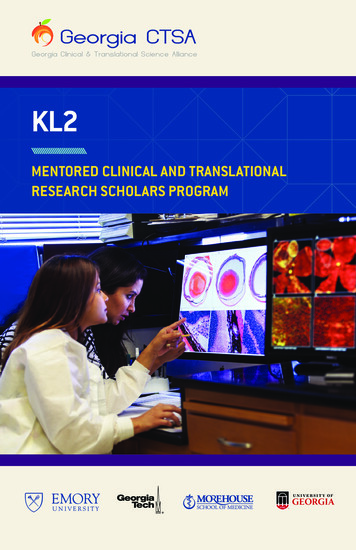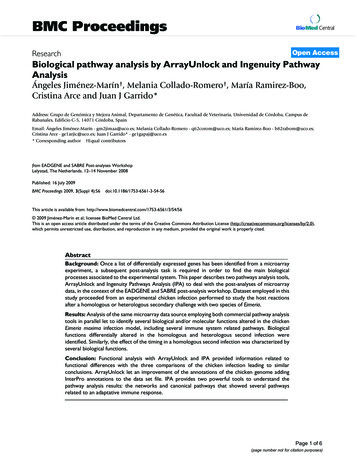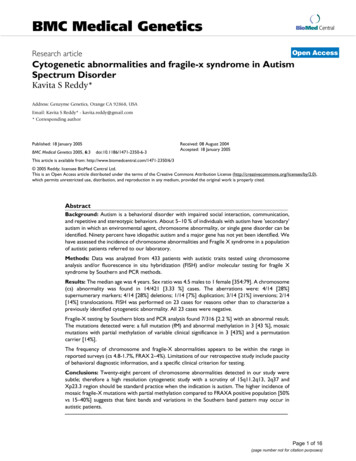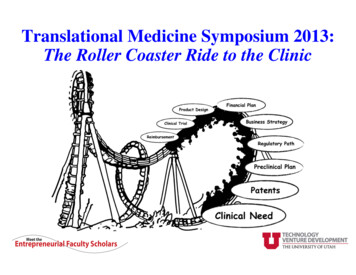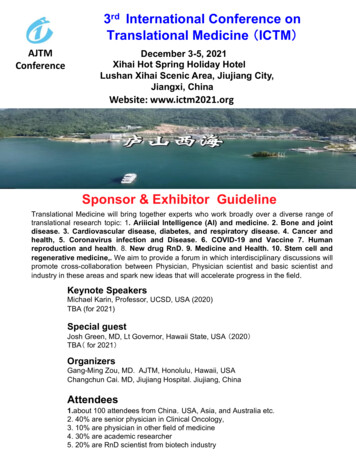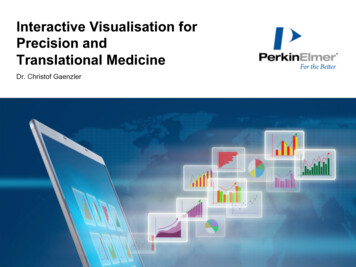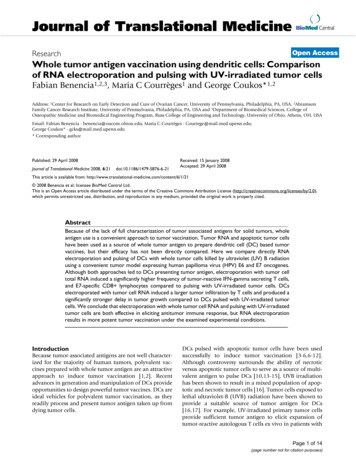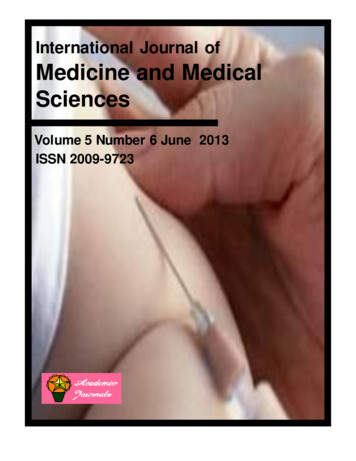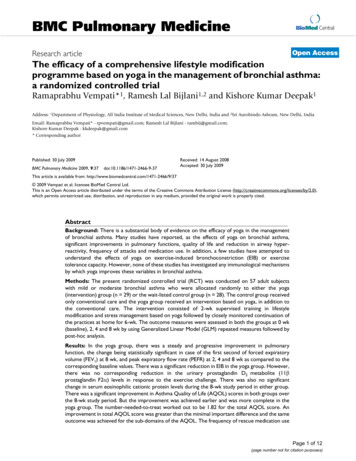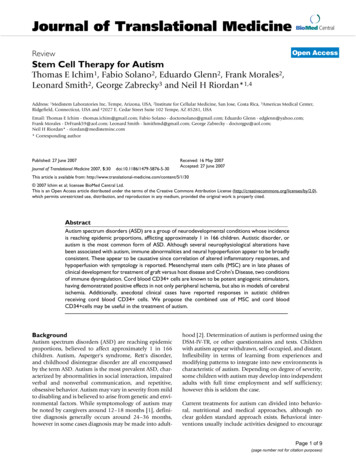
Transcription
Journal of Translational MedicineBioMed CentralOpen AccessReviewStem Cell Therapy for AutismThomas E Ichim1, Fabio Solano2, Eduardo Glenn2, Frank Morales2,Leonard Smith2, George Zabrecky3 and Neil H Riordan*1,4Address: 1Medistem Laboratories Inc, Tempe, Arizona, USA, 2Institute for Cellular Medicine, San Jose, Costa Rica, 3Americas Medical Center,Ridgefield, Connecticut, USA and 42027 E. Cedar Street Suite 102 Tempe, AZ 85281, USAEmail: Thomas E Ichim - thomas.ichim@gmail.com; Fabio Solano - doctorsolano@gmail.com; Eduardo Glenn - edglenn@yahoo.com;Frank Morales - DrFrank59@aol.com; Leonard Smith - lsmithmd@gmail.com; George Zabrecky - doctorgpz@aol.com;Neil H Riordan* - riordan@medisteminc.com* Corresponding authorPublished: 27 June 2007Journal of Translational Medicine 2007, 5:30doi:10.1186/1479-5876-5-30Received: 16 May 2007Accepted: 27 June 2007This article is available from: 30 2007 Ichim et al; licensee BioMed Central Ltd.This is an Open Access article distributed under the terms of the Creative Commons Attribution License (http://creativecommons.org/licenses/by/2.0),which permits unrestricted use, distribution, and reproduction in any medium, provided the original work is properly cited.AbstractAutism spectrum disorders (ASD) are a group of neurodevelopmental conditions whose incidenceis reaching epidemic proportions, afflicting approximately 1 in 166 children. Autistic disorder, orautism is the most common form of ASD. Although several neurophysiological alterations havebeen associated with autism, immune abnormalities and neural hypoperfusion appear to be broadlyconsistent. These appear to be causative since correlation of altered inflammatory responses, andhypoperfusion with symptology is reported. Mesenchymal stem cells (MSC) are in late phases ofclinical development for treatment of graft versus host disease and Crohn's Disease, two conditionsof immune dysregulation. Cord blood CD34 cells are known to be potent angiogenic stimulators,having demonstrated positive effects in not only peripheral ischemia, but also in models of cerebralischemia. Additionally, anecdotal clinical cases have reported responses in autistic childrenreceiving cord blood CD34 cells. We propose the combined use of MSC and cord bloodCD34 cells may be useful in the treatment of autism.BackgroundAutism spectrum disorders (ASD) are reaching epidemicproportions, believed to affect approximately 1 in 166children. Autism, Asperger's syndrome, Rett's disorder,and childhood disintegrae disorder are all encompassedby the term ASD. Autism is the most prevalent ASD, characterized by abnormalities in social interaction, impairedverbal and nonverbal communication, and repetitive,obsessive behavior. Autism may vary in severity from mildto disabling and is believed to arise from genetic and environmental factors. While symptomology of autism maybe noted by caregivers around 12–18 months [1], definitive diagnosis generally occurs around 24–36 months,however in some cases diagnosis may be made into adult-hood [2]. Determination of autism is performed using theDSM-IV-TR, or other questionnaires and tests. Childrenwith autism appear withdrawn, self-occupied, and distant.Inflexibility in terms of learning from experiences andmodifying patterns to integrate into new environments ischaracteristic of autism. Depending on degree of severity,some children with autism may develop into independentadults with full time employment and self sufficiency;however this is seldom the case.Current treatments for autism can divided into behavioral, nutritional and medical approaches, although noclear golden standard approach exists. Behavioral interventions usually include activities designed to encouragePage 1 of 9(page number not for citation purposes)
Journal of Translational Medicine 2007, 5:30social interaction, communication, awareness of self, andincrease attention. Nutritional interventions aim torestrict allergy-associated dietary components, as well asto supplement minerals or vitamins that may be lacking.Medical interventions usually treat specific activities associated with autism. For example, serotonin reuptakeinhibitors (SSRI's) such as fluoxetine, fluvoxamine, sertraline, and clomipramine, are used for treatment of anxietyand depression. Some studies have shown that SSRI's alsohave the added benefit of increasing social interaction andinhibiting repetitive behavior. Typical antipsychotic drugssuch as thioridazine, fluphenazine, chlorpromazine, andhaloperidol have been showed to decrease behavioralabnormalities in autism. Atypical antipsychotics such asrisperidone, olanzapine and ziprasidone have also demonstrated beneficial effect at ameliorating behavioralproblems. Autism associated seizures are mainly treatedby administration of anticonvulsants such as carbamazepine, lamotrigine, topiramate, and valproic acid.Attention deficient/hyperactivity is treated by agents suchas methylphenidate (Ritalin ).Currently, numerous clinical trials are being conductedwith interventions ranging from hyperbaric oxygen, toadministration of zinc, to drugs exhibiting anti-inflammatory properties. Unfortunately, no clear understanding ofautism's pathogenic mechanisms exists, and as a resultnumerous strategies are being attempted with varyingdegrees of success. In this paper we examine two pathologies associated with autism – hypoperfusion to the brainand immune dysregulation – and propose a novel treatment: the administration of CD34 umbilical cord cellsand mesenchymal cells.Hypoperfusion of brain in autismChildren with autism have been consistently shown tohave impaired, or subnormal CNS circulation, as well asresulting hypoxia. Defects include basal hypoperfusion[3], and decreased perfusion in response to stimuli thatunder normal circumstances upregulates perfusion [4]. Innumerous studies the areas affected by hypoperfusionseem to correlate with regions of the brain that are responsible for functionalities that are abnormal in autism. Forexample, specific temporal lobe areas associated with facerecognition [5], social interaction [6], and language comprehension [7], have been demonstrated to be hypoperfused in autistic but not control children.The question of cause versus effect is important. If temporal lobe ischemia is not causative but only a symptom ofan underlying process, then targeting this pathology maybe non-productive from the therapeutic perspective. However this appears not to be the case. It is evident that thedegree of hypoperfusion and resulting hypoxia correlateswith the severity of autism symptoms. For example, nt/5/1/30tically significant inverse correlation has been demonstrated between extent of hypoxia and IQ [8]. Supportinga causative effect of hypoperfusion to autism development, Bachavelier et al reviewed numerous experimentalreports of primate and other animal studies in whichdamage causing hypoperfusion of temporal areas wasassociated with onset of autism-like disorders [9]. It is alsoknown that after removal or damage of the amygdala, hippocampus, or other temporal structures induces eitherpermanent or transient autistic-like characteristics such asunexpressive faces, little eye contact, and motor stereotypies occurs. Clinically, temporal lobe damage by viral andother means has been implicated in development ofautism both in adults [10], and children [11-14].Evidence suggests that hypoperfusion and resultinghypoxia is intimately associated with autism, however thenext important question is whether reversion of thishypoxia can positively influence autism. In autism theassociated hypoxia is not predominantly apoptotic ornecrotic to temporal neurons but associated with alteredfunction [15]. Hypoperfusion may contribute to defectsnot only by induction of hypoxia but also allowing forabnormal metabolite or neurotransmitter accumulation.This is one of the reasons why glutamate toxicity has beenimplicated in autism [16] and a clinical trial at reversingthis using the inhibitor of glutamate toxicity, Riluzole, iscurrently in progress [17]. Conceptually the augmentationof perfusion through stimulation of angiogenesis shouldallow for metabolite clearance and restoration of functionality. Although not well defined, cell death may alsobe occurring in various CNS components of autistic children. If this were the case, it is possible that neural regeneration can be stimulated through entry of neuronalprogenitor cells into cell cycle and subsequent differentiation. Ample evidence of neural regeneration exists in areasranging from stroke [18], to subarachinoidal hemorrhage[19,20], to neural damage as a result of congenital errorsof metabolism [21]. Theoretically, it is conceivable thatreversing hypoxia may lead to activation of self-repairmechanisms. Such neural proliferation is seen after reperfusion in numerous animal models of cerebral ischemia[22-24]. The concept of increasing oxygen to the autisticbrain through various means such as hyperbaric medicineis currently being tested in 2 independent clinical trials inthe US [25,26]. However, to our knowledge, the use of celltherapy to stimulate angiogenesis has not been widelyused for the treatment of autism.Immune deregulation in autismThe fundamental interplay between the nervous systemand the immune system cannot be understated. Philosophically, the characteristics of self/nonself recognition,specificity, and memory are only shared by the immunesystem and the nervous system. Physically, every immunePage 2 of 9(page number not for citation purposes)
Journal of Translational Medicine 2007, 5:30organ is innervated and bi-directional communicationbetween neural and immune system cells has been established in numerous physiological systems. In autism, several immunological abnormalities have been detectedboth in the peripheral and the central nervous systems.Astroglial cells, or astrocytes, surround various portions ofthe cerebral endothelium and play a critical role in regulating perfusion [27,28], and blood brain barrier function[29]. Astrocytes are capable of mediating several immunological/inflammatory effects. Expression of various tolllike receptors (TLR) on astrocytes endows the ability torecognize not only bacterial and viral signals but alsoendogenous "danger" signals such as heat shock proteins,fibrinogen degradation products, and free DNA [30].Physiologically, astrocytes play an important protectiverole against infection, generating inflammatory cytokinessuch as TNF-alpha, IL-1beta, and IL-6 [31]. Through secretion of various chemokines such as CXCL10, CCL2 andBAFF, astrocytes play an important role in shaping adaptive immune responses in the CNS [32]. Astrocytes haveantigen presenting capabilities and have been demonstrated to activate T and B cell responses against exogenous and endogenous antigens [33,34]. Althoughastrocytes play a critical role against CNS infection, thesecells also have potential to cause damage to the host whenfunctioning in an aberrant manner. For example, variousneurological diseases are associated with astrocyte overproduction of inflammatory agents, which causes neuralmalfunction or death. In amyotrophic lateral sclerosis(ALS), astrocyte secretion of a soluble neurotoxic substance has been demonstrated to be involved in diseaseprogression [35,36]. Astrocyte hyperactivation has beendemonstrated in this disease by imaging, as well asautopsy studies [37-39]. In multiple sclerosis, astrocytesplay a key role in maintaining autoreactive responses andpathological plaque formation [40,41]. In stroke, activated astrocytes contribute to opening of the blood brainbarrier [42], as well as secrete various neurotoxic substances that contribute to post infarct neural damage[43,44].Vargas et al compared brain autopsy samples from 11autistic children with 7 age-matched controls. They demonstrated an active neuroinflammatory process in the cerebral cortex, white matter, and notably in cerebellum ofautistic patients both by immunohistochemistry andmorphology. Importantly, astrocyte production ofinflammatory cytokines was observed, including production of cytokines known to affect various neuronal functions such as TNF-alpha and MCP-1. CSF samples fromliving autism patients but not controls also displayedupregulated inflammatory cytokines as demonstrated byELISA [45]. The potent effects of inflammatory cytokineson neurological function cannot be underestimated. /1/30example, patients receiving systemic IFN-gamma therapyfor cancer, even though theoretically the protein shouldnot cross the blood brain barrier, report numerous cognitive and neurological abnormalities [46,47]. In fact, IFNgamma, one of the products of activated astrocytes [46],has been detected at elevated levels in the plasma of children with autism [48,49]. Mechanistically, inflammatorymediators mediate alteration of neurological functionthrough a wide variety of different pathways, eitherdirectly altering neuron activity or indirectly. For example,the common neurotoxin used in models of Parkinson'sDisease, MPTP is believed to mediate its activity throughactivation of IFN-gamma production, leading to directkilling of dopaminergic neurons in the substantia nigra.This is evidenced by reduced MPTP neuronal toxicity inIFN-gamma knockout mice or by addition of blockingantibodies to IFN-gamma [50]. In terms of indirect effectsof IFN-gamma, it is known that this cytokine activates theenzyme 2,3-indolaminedeoxygenase, leading to generation of small molecule neurotoxins such as the kynurenine metabolites 3OH-kynurenine and quinolinic acidwhich have been implicated in dementias associated withchronic inflammatory states [51,52].T cell and B cell abnormalities have been reported systemically in autistic children. These have included systemic Tcell lymphopenia, weak proliferative responses tomitogens, and deranged cytokine production [53,54]. Atface value, lymphopenia would suggest general immunedeficiency and as a result little inflammation, however,recent studies have demonstrated that almost all autoimmune diseases are associated with a state of generalizedlymphopenia (reviewed by Marleau and Sarvetnick [55]).Autoimmune-like pathophysiology appears to be prevalent in autism and several lines of reasoning suggest it maybe causative. Firstly, numerous types of autoantibodieshave been detected in children with autism but not inhealthy or mentally challenged controls. These includeantibodies to myelin basic protein [56], brain extracts[57,58], Purkinje cells and gliadin extracted peptides [59],neutrophic factors [60,61], and neuron-axon filament andglial fibrillary acidic protein [61]. Secondly, family members of autistic children have a higher predispositiontowards autoimmunity compared to control populations[62,63]. Hinting at genetic mechanisms are observationsthat specific HLA haplotypes seem to associate withautism [64,65]. Another genetic characteristic associatedwith autism is a null allele for the complement component C4b [66]. Both HLA haplotypes as well as complement component gene polymorphisms have beenstrongly associated with autoimmunity [67-69]. It isknown that autoimmune animals have altered cognitiveability and several neurological abnormalities [70].Thirdly, autism has been associated with a peculiarautoimmune-like syndrome that is still relatively unde-Page 3 of 9(page number not for citation purposes)
Journal of Translational Medicine 2007, 5:30fined. Mucosal lesions in the form of chronic ileocoloniclymphoid nodular hyperplasia characterized by lymphocyte infiltration, complement deposition, andcytokine production have been described uniquely tochildren with autism but not healthy controls or cerebralpalsy patients [71]. This inflammatory condition is associated not only with lesions on the intestinal wall, but alsoin the upper GI tract. Although several characteristics ofthis condition are shared with Crohn's Disease, oneunique aspect is eosinophilic infiltrate, which seems to beassociated with dietary habits of the patient [72]. Systemicmanifestation of the immune deregulation/chronicinflammatory condition are observed through elevatedlevels of inflammatory cytokines such as IFN-gamma [73],IL-12 [74], and TNF-alpha [75]. Indication that a relevantinflammatory response is ongoing is provided by observation that the macrophage product neopterin is observedelevated in children with autism [76]. Inhibited production of anti-inflammatory cytokines such as IL-10 [77]and TGF-beta [78] has also been observed in children withautism, thus suggesting not only augmentation of inflammatory processes but also deficiency of natural feedbackinhibitor mechanisms.The systemic effects of a chronic inflammatory process inthe periphery may result in production of soluble factorssuch as quinilonic acid, which have neurotoxin activity.Ability of cellular immune deregulation to affect neuralfunction can occur independent of cell trafficking, as wasdemonstrated in animal studies in which T cell depletionwas associated with cognitive loss of function that wasreversible through T cell repletion [79]. Localized inflammation and pathological astrocyte activation has beendirectly demonstrated to be associated with pathogenesisin autism. Clinical trials of inflammatory drugs have demonstrated varying degrees of success. For example, in anopen labeled study of the anti-inflammatory PPARgamma agonist pioglitozone in 25 children, 75% reportedresponses on the aberrant behavior checklist [80]. Otherinterventions aimed at reducing inflammation such asintravenous immunoglobulin administration reportedinconsistent results, however a minor subset did respondsignificantly [81,82]. Clinical trials are currently usingdrugs off-label for treatment of autism through inhibitinginflammation such as minocycline [83], n-acetylcysteine[84], or ascorbic acid and zinc [85]. Despite the desire tocorrect immune deregulation/chronic inflammation inautism, to date, no approach has been successful.Treatment of hypoperfusion defect by umbilicalcord blood CD34 stem cell administrationTherapeutic angiogenesis, the induction of new blood vessels from preexisting arteries for overcoming ischemia, hasbeen experimentally demonstrated in peripheral arterydisease [86], myocardial ischemia [87], and stroke /5/1/30Angiogenesis is induced through the formation of collateral vessels and has been observed in hypoperfused tissues. This process is believed to be coordinated by theoxygen sensing transcription factor hypoxia inducible factor-1 (HIF-1). During conditions of low oxygen tension,various components of the transcription factor dimerizeand coordinately translocate into the nucleus causingupregulation of numerous cytokines and proteins associated with angiogenesis such as SDF-1, VEGF, FGF, andmatrix metalloproteases [89]. The potency of tissueischemia stimulating angiogenesis is seen in patients aftermyocardial infarction in which bone marrow angiogenicstem cells mobilize into systemic circulating in responseto ischemia induced chemotactic factors [90]. The angiogenic response has also been demonstrated to occurafter cerebral ischemia in the form of stroke and isbelieved to be fundamental in neurological recovery [91].For example, in models of middle cerebral artery occlusion, endogenous angiogenesis occurs which is alsoinvolved in triggering migration of neural stem cells intodamaged area that participate in neuroregeneration [92].The association between neural angiogenesis and neurogenesis after brain damage is not only temporally-linkedbut also connected by common mediators, for example,SDF-1 secreted in response to hypoxia also induces migration of neural progenitors [92]. Angiogenic factors such asVEGF and angiopoietin have been implicated in postischemia neurogenesis [93].While recovery after cerebral ischemia occurs to someextent without intervention, this recovery is can be limited. Methods to enhance angiogenesis and as a resultneurogenesis are numerous and have utilized approachesthat upregulate endogenous production of reparative factors, as well as administration of exogenous agents. Forexample, administration of exogenous cytokines such asFGF-2 [94], erythropoietin [95], and G-CSF [96], has beenperformed clinically to accelerate healing with varyingdegrees of success.A promising method of increasing angiogenesis in situations of ischemia is administration of cells with potentialto produce angiogenic factors and the capacity to differentiate into endothelial cells themselves. Accordingly, theuse of CD34 stem cells has been previously proposed asan alternative to growth factor administration [97]. Therapeutic administration of bone marrow derived CD34 cells has produced promising results in the treatment ofend-stage myocardial ischemia [98], as well as a type ofadvanced peripheral artery disease called critical limbischemia [99]. Additionally, autologous peripheral bloodCD34 cells have also been used clinically with inductionof therapeutic angiogenesis [100]. Of angiogenesis stimulating cell sources, cord blood seems to possess CD34 cells with highest activity in terms of proliferation,Page 4 of 9(page number not for citation purposes)
Journal of Translational Medicine 2007, 5:30cytokine production, as well as endothelial differentiation[101,102].Cord blood has been used successfully for stimulation ofangiogenesis in various models of ischemia. In one report,the CD34 , CD11b fraction, which is approximately lessthan half of the CD34 fraction of cord blood was demonstrated to possess the ability to differentiate intoendothelial cells [102]. In another report, VEGF-R3 ,CD34 cells demonstrated the ability to differentiate intoendothelial cells and were able to be expanded 40-foldexpansion. The concentration of this potential endothelial progenitor fraction in cord blood CD34 cells isapproximately tenfold higher as compared to bone marrow CD34 cells (1.9% /- 0.8% compared to 0.2% /0.1%) [103]. Administration of cord blood CD34 cellsinto immune compromised mice that underwent middlecerebral artery ligation reduced neurological deficits andinduce neuroregeneration, in part through secretion ofangiogenic factors [104]. Several studies have confirmedthat systemic administration of cord blood cells is sufficient to induce neuroregeneration [105-107]. Given thepotency of cord blood CD34 cells to induce angiogenesisin areas of cerebral hypoperfusion, we propose that thiscell type may be particularly useful for the treatment ofautism, in which ischemia is milder than stroke inducedischemia, and as a result the level of angiogenesis neededis theoretically lower. However at face value, several considerations have to be dealt with. Firstly, cord blood contains a relatively low number of CD34 cells for clinicaluse. Secondly, very few patients have access to autologouscord blood; therefore allogeneic cord blood CD34 cellsare needed if this therapy is to be made available for widespread use. There is a belief that allogeneic cord bloodcells can not be used without immune suppression toavoid host versus graft destruction of the cells.Numerous laboratories are currently attempting toexpand cord blood CD34 cells, achieving varying degreesof success. Expansion methods typically involve administration of cytokines, and or feeder cell layers [108-110].The authors have developed a CD34 expansion protocolthat yields up to 60-fold expansion with limited cell differentiation. This expansion method involves numerousgrowth factors and conditioned medium, however is performed under serum free conditions (manuscript in preparation). Currently over 100 patients have been treated byone of the authors (FS) with expanded CD34 cells underlocal ethical approval with varying degrees of success.Since other groups are also generating CD34 expansiontechnologies, we do not anticipate number of CD34 cellsto be a problem.Safety concerns regarding allogeneic CD34 cells aredivided into fears of graft versus host reactions, as well 1/30host versus graft. The authors of the current paper haverecently published a detailed rationale for why administration of cord blood cells is feasible in absence ofimmune suppression [111]. Essentially, GVHD occurs inthe context of lymphopenia caused by bone marrow ablation. Administration of cord blood has been reported inover 500 patients without a single one suffering GVHD ifno immune suppression was used [112-115]. Althoughhost versus graft may conceptually cause immune mediated clearing of cord blood cells, efficacy of cord bloodcells in absence of immune suppression has also beenreported [116-118]. Accordingly, we believe that systemicadministration of expanded cord blood derived CD34 cells may be a potent tool for generation of neoangiogenesis in the autistic brain.Immune modulation by mesenchymal stem cellsThe treatment of immune deregulation in autism isexpected to not only cause amelioration of intestinal andsystemic symptomology, but also to profoundly influenceneurological function. Reports exist of temporary neurological improvement by decreasing intestinal inflammation through either antibiotic administration [119] ordietary changes [120]. Although, as previously discussed,some anti-inflammatory treatments have yielded beneficial effects, no clinical agent has been developed that canprofoundly suppress inflammation at the level of the fundamental immune abnormality. We believe mesenchymalstem cell administration may be used for this purpose.This cell type, in allogeneic form, is currently in Phase IIIclinical studies for Crohn's disease and Phase II resultshave demonstrated profound improvement [121].Mesenchymal stem cells are classically defined as "formative pluripotential blast cells found inter alia in bone marrow, blood, dermis and periosteum that are capable ofdifferentiating into any of the specific types of mesenchymal or connective tissues. These cells are routinely generated by culture of bone marrow in various culture mediaand collection of the adherent cell population. Thisexpansion technique is sometimes used in combinationwith selection procedures for markers described above togenerate a pure population of stem cells. An importantcharacteristic of mesenchymal stem cells is their ability toconstitutively secrete immune inhibitory factors such asIL-10 and TGF-b while maintaining ability to present antigens to T cells [122,123]. This is believed to further allowinhibition of immunity in an antigen specific manner, aswell as to allow the use of such cells in an allogeneic fashion without fear of immune-mediated rejection. Antigenspecific immune suppression is believed to allow thesecells to shut off autoimmune processes. Further understanding of the immune inhibitory effects of mesenchymal stem cells comes from the fact that during T cellactivation, two general signals are required for the T cell inPage 5 of 9(page number not for citation purposes)
Journal of Translational Medicine 2007, 5:30order to mount a productive immune response, the firstsignal is recognition of antigen, and the second is recognition of costimulatory or coinhibitory signals. Mesenchymal cells present antigens to T cells but provide acoinhibitory signal instead of a co-stimulatory signal, thusspecifically inhibiting T cells that recognize them, andother cells expressing similar antigens. Supporting thisconcept, it was demonstrated in a murine model that mesenchymal stem cell transplantation leads to permanentdonor-specific immunotolerance in allogeneic hosts andresults in long-term allogeneic skin graft acceptance [124].Other studies have shown that mesenchymal stem cellsare inherently immunosuppressive through production ofPGE-2, interleukin-10 and expression of the tryptophancatabolizing enzyme indoleamine 2,3,-dioxygenase aswell as Galectin-1 [125,126].These stem cells also have the ability to non-specificallymodulate the immune response through the suppressionof dendritic cell maturation and antigen presenting abilities [127,128]. Immune suppressive activity is notdependent on prolonged culture of mesenchymal stemcells since functional induction of allogeneic T cell apoptosis was also demonstrated using freshly isolated, irradiated, mesenchymal stem cells [129]. Others have alsodemonstrated that mesenchymal stem cells have the ability to preferentially induce expansion of antigen specific Tregulatory cells with the CD4 CD25 phenotype [130].Supporting the potential clinical utility of such cells, itwas previously demonstrated that administration of mesenchymal stem cells inhibits antigen specific T cellresponses in the murine model of multiple sclerosis,experimental autoimmune encephalomyelitis, leading toprevention and/or regression of pathology [131]. Safety ofinfusing mesenchymal stem cells was illustrated in studiesadministering 1–2.2 106 cells/kg in order to enhanceengraftment of autologous bone marrow cell. No adverseevents were associated with infusion, although level ofengraftment remained to be analyzed in randomized trials [132]. The ability of mesenchymal stem cells on onehand to suppress pathological immune responses but onthe other hand to stimulate hematopoiesis leads to thepossibility that these cells may also be useful for treatmentof the defect in T cell numbers associated with nt/5/1/30markers of hypoxia will be included. In order to initiatesuch an investigation, specific inclusion/exclusion criteriawill be developed taking into account a population mostlikely to benefit from such an intervention. Criteria of particular interest would include defined hypoxia areas, aswell as frank clinical manifestations of inflammatoryintestinal
BioMed Central Page 1 of 9 (page number not for citation purposes) Journal of Translational Medicine Review Open Access Stem Cell Therapy for Autism Thomas E Ichim1, Fabio Solano 2, Eduardo Glenn , Frank Morales2, Leonard Smith2, George Zabrecky3 and Neil H Riordan*1,4 Address: 1Medistem Laboratories Inc, Tempe, Arizona, USA, 2Institute for Cellular Medicine, San Jose, Costa Rica, 3Americas .
